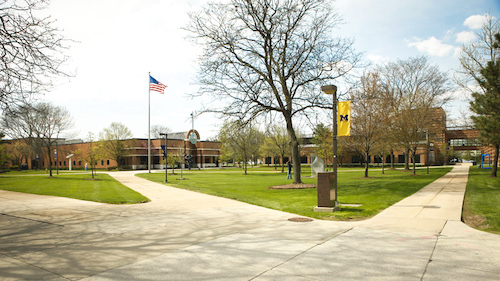
Spring time is budgeting time at UM-Dearborn, and even under normal circumstances, you can expect a bit of uncertainty as the enrollment picture materializes and we all speculate about the size of the state appropriation. This year being anything but normal, university leadership spent Tuesday answering your questions about UM-Dearborn’s current and future financial health at a virtual town hall event, as well as introducing our new Vice Chancellor for Business Affairs Bryan Dadey. We’ve recapped some of the big takeaways below, in case you missed it. Or you can watch the full event on the university YouTube channel.
Two new tools for budgeting at UM-Dearborn, explained
Typically, the discussion at our budget town hall events centers on things like enrollment and revenue. At Tuesday’s event, however, folks had the most questions about two new tools that the university is using to craft future budgets. The first is called zero-based budgeting (ZBB). This is a method of building a base budget for each campus unit based on exactly what it needs to accomplish its present mission (rather than, say, what its budget has been historically). In practice, this means the administration and unit leaders will be spending the next few months finalizing exactly what those core needs and base budgets should look like, which will then inform the university’s overall fiscal year ‘22 (FY22) budget.
The second strategy is known as responsibility center management (RCM). This is a decentralized budgeting model in which individual academic units are responsible for both revenue and expenses. This is typically decentralized down to the college level, with the idea that each unit would get all the revenue it generates from tuition, research, etc., but it would also have to take care of all expenses related to those activities. There are a few nuances in using an RCM-based approach. Let’s say, for example, you have tuition dollars that derive from a mechanical engineering major in CECS taking a calculus class that is taught by the math department in CASL. In that case, the revenue would actually be shared between both colleges (the exact split that is best suited to UM-Dearborn is still to be determined). Similarly, through a process known as subvention, the university could help support programs that might not be able to generate enough revenue to be self-sustaining. These are just a few examples of how RCM might work, and you’ll hear more about both ZBB and RCM as the new budget takes shape in the coming months.
The university benefited from sound planning
When the pandemic hit, no one knew how deeply the university’s finances would be affected. Now, about a year since we moved to a predominantly remote class format, we can say we are weathering the storm pretty well. Our estimated revenues for FY21 are expected to be only $400,000 behind budget, and expenses are expected to be well under budget due to prudent decisions, federal aid and savings resulting from the partial campus closure. Although overall enrollment decreased slightly, it was no greater than what we predicted in our models. And while we did face a decline in our state appropriation, it was basically offset by emergency federal funding from the CARES Act and critical savings measures implemented last spring, like our hiring and spending pause.
Next year’s budget will be fine-tuned as the enrollment picture becomes more certain (more on that below). As for the state appropriation, Governor Whitmer has proposed a 2 percent one-time increase, but that must still be approved by the legislature. Chancellor Grasso mentioned that we’re shooting for the FY22 budget to include merit pay increases. That, and other details, will be worked out over the next few months by the university’s budget office in consultation with the university budget committee and senior leadership. The budget will eventually be submitted for approval by the U-M Board of Regents in June.
Looking even further out, the core challenges facing UM-Dearborn remain the same: Our revenues come almost exclusively from two sources — tuition and our state appropriation — which makes us extremely sensitive to fluctuations in either. Second, a shrinking number of Michigan high school graduates means competition for students is increasingly intense.
New Fall 2021 enrollment looks good, but it’s still early
Very few universities saw their usual enrollment numbers during the pandemic, and many of our peer institutions saw some significant declines. While UM-Dearborn did take a hit in a few areas, our enrollment numbers have remained fairly strong overall. Enrollment among new first-year students declined only about 5 percent compared to last year; new transfer students were down about 21 percent, which was part of a nationwide trend; and graduate student enrollment declined about 14 percent, which was largely due to uncertainties around student visas and travel restrictions imposed by the pandemic. However, consistent retention in all areas provided a decent counterweight to offset some of these pandemic-related declines. Overall, by headcount, enrollment was only off about 5 percent compared to last year.
We’re just starting to get our first hints of what new Fall 2021 enrollment might look like. Vice Provost of Enrollment Management Melissa Stone says there are some bright spots in the preliminary numbers but cautioned it is too early to really know what is in store for the fall. Compared to this time last year, first-year applications are up almost 3 percent, and admitted first-year students are up 5 percent. Transfers are a little off last year’s pace, though enrollment for this group typically materializes much later, so there’s still time to make up ground. Most notably, though, graduate enrollment appears poised for a possible rebound. Applications are up 27 percent, and admitted students are up almost 50 percent compared to this time last year, although this of course is dependent on the international landscape.
In the short term, Stone says the overall enrollment landscape will take time to recover from the pandemic. But this past year reflects how effective planning will manage this regrowth. In addition, our ongoing focus on impactful strategic initiatives to enhance recruitment and retention will help move us forward.
Looking even further out, two new state programs could bolster the future transfer student pipeline. Futures for Frontliners is offering free community college tuition for frontline workers; while Michigan Reconnect offers the same benefit to Michiganders 25 and older. And the university has just announced the Focus on the Finish program to encourage students in these programs to consider UM-Dearborn for a bachelor’s degree once they complete their associate degree.
###
Want more details from the March 2 Budget Town Hall? You can view the full recording on the university YouTube channel or view the budget PowerPoint slides online.





